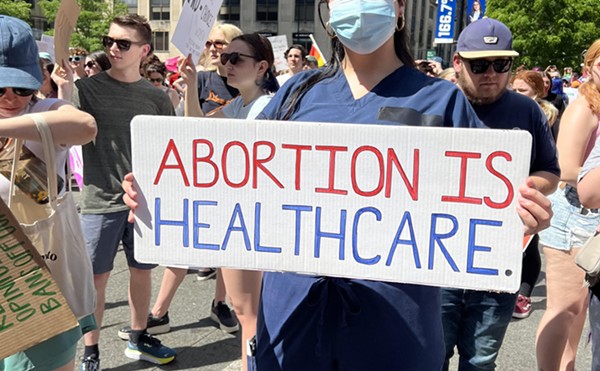|
By Jan. 1, 2005, residents and companies in Walnut Hills will be able to surf the Internet, check e-mail or conduct business on the largest metropolitan WiFi network in the United States.
WiFi, short for "wireless fidelity," allows computer users to access the Internet without having to plug their computers into jacks in the wall. Data signals are sent over the air, like music to a radio.
To organizers of the grid, the scope of their achievement is merely the bait to lure you in so they can talk about what really gets them jazzed: building community with technology. The size of the grid is merely a result of the size of the neighborhood. Community comes first.
Frank Moore, interim president of Victory Neighborhood Services Agency and enthusiastic advocate for the WiFi project, describes Walnut Hills as a planned community focused on civic, social, economic and physical development.
"Meaning Walnut Hills has a plan, a vision," he says. "It has always had a plan or some kind of document that guided what happened in those four areas."
Utilizing technology is just the latest method to further address the needs of the neighborhood defined by the 45206 Zip code.
A community brainstorming session held in December 2003 brought neighborhood leaders together to define the latest challenges facing residents — individuals, families and businesses. With such a broad audience, a starting point had to be chosen.
"Our goal is to address 'Vanessa,' " Moore says. "Vanessa is our target demographic. She's a single female with multiple children, usually receiving some kind of subsidy — unemployed, looking for work — or with multiple quality-of-life issues."
Doing it for Vanessa
The group concluded Vanessa needs to be empowered to provide for herself and her children by having the kind of job that allows her to work from home. That requires hardware, software, training and access to the job market.
Many of those pieces exist in some form as a result of the community development work already underway: training labs and classes through Mercy Connections, low-cost refurbished computer systems from the Full Circle Group. In addition, libraries and schools provide some access to the Internet.
The key pieces that were missing were affordable, on-demand Internet access at home and delivering the existing resources, including information, to those who need them. That's where the WiFi technology comes in.
The mechanism needed to connect any location in the 45206 area to the Internet was also in place, in the form of security cameras installed by
|
slim Jim Puvee
|
By Jan. 1, 2005, residents and companies in Walnut Hills will be able to surf the Internet, check e-mail or conduct business on the largest metropolitan WiFi network in the United States.
WiFi, short for "wireless fidelity," allows computer users to access the Internet without having to plug their computers into jacks in the wall. Data signals are sent over the air, like music to a radio.
To organizers of the grid, the scope of their achievement is merely the bait to lure you in so they can talk about what really gets them jazzed: building community with technology. The size of the grid is merely a result of the size of the neighborhood. Community comes first.
Frank Moore, interim president of Victory Neighborhood Services Agency and enthusiastic advocate for the WiFi project, describes Walnut Hills as a planned community focused on civic, social, economic and physical development.
"Meaning Walnut Hills has a plan, a vision," he says. "It has always had a plan or some kind of document that guided what happened in those four areas."
Utilizing technology is just the latest method to further address the needs of the neighborhood defined by the 45206 Zip code.
A community brainstorming session held in December 2003 brought neighborhood leaders together to define the latest challenges facing residents — individuals, families and businesses. With such a broad audience, a starting point had to be chosen.
"Our goal is to address 'Vanessa,' " Moore says. "Vanessa is our target demographic. She's a single female with multiple children, usually receiving some kind of subsidy — unemployed, looking for work — or with multiple quality-of-life issues."
Doing it for Vanessa
The group concluded Vanessa needs to be empowered to provide for herself and her children by having the kind of job that allows her to work from home. That requires hardware, software, training and access to the job market.
Many of those pieces exist in some form as a result of the community development work already underway: training labs and classes through Mercy Connections, low-cost refurbished computer systems from the Full Circle Group. In addition, libraries and schools provide some access to the Internet.
The key pieces that were missing were affordable, on-demand Internet access at home and delivering the existing resources, including information, to those who need them. That's where the WiFi technology comes in.
The mechanism needed to connect any location in the 45206 area to the Internet was also in place, in the form of security cameras installed by CityWatcher.com. They use WiFi to deliver streaming video, so all that was needed were some inexpensive upgrades to expand the wireless signal to include data.
Developing the infrastructure needed to support the WiFi mesh grid provided an opportunity to bring together all of the community resources under one umbrella. Thus neighborhoodworks.net was formed. Legally structured as a cooperative, neighborhoodworks.net will be owned and operated by residents of Walnut Hills as the means to organize, manage and deliver the resources Vanessa needs to achieve independence. Organizers prefer to call it a "democrative," because its definition is an "economic democracy."
Installers, help desk support and the democrative administrative staff will manage the day-to-day activities necessary to provide low cost or free Internet access to members — individuals and businesses alike. They will also manage the coordination of training, hardware, software and community outreach activities.
The idea of utilizing technology to build community is already getting serious attention from other cities and major mesh grid proponents, many of whom attended the 2004 National Summit for Community Wireless Networks in August in Champaign-Urbana, Ill.
Pat Woodward, principal consultant of Keyedge — the technology partner for the initiative — attended the event. Other cities are just now facing issues that the Walnut Hills initiative has already covered, she says.
"All these other cities have their wireless up and the techie people know what's going on," she says. "But they're struggling with issues like 'How do we sustain it?' How do we fund it? How doe we get people to use it? And how can people use it?"
Fred Siff, chief information officer at the University of Cincinnati, commends the Walnut Hills WiFi initiative.
"They're leading edge," he says. "It says a lot about them and their leadership."
No government allowed
Free and widely available Internet access is going to become a significant differentiation for communities, much as it is now for individual businesses, according to Siff.
"We need to rethink the definition of community," he says. "What does community provide? Police, fire. Why not WiFi like water or energy?"
Moore and the other organizers have fought to keep focused on their community and its needs. The vision of the democrative is to provide everyone who needs access with the means to obtain it. The reality is some people can't afford a telephone, let alone inexpensive Internet service. Organizers are seeking money from businesses and individuals to cover the cost of providing free access until residents are in a position to pay for it themselves. Low-income people could exchange community service for access to the information superhighway.
The plan remains true to its grassroots origins because the organizers have chosen to forego city, state and federal funding sources, which might restrict or manipulate the vision of the democrative.
"My attitude has always been the community has the strengths inherent in it to do this and we just need to find the pieces," Moore says. "We need to bring the right partners to the table, and I'm not going to let the community's vision be co-opted or jeopardized by the politics of funding, whether it be community development block grant, HUD or whatever. They put a political price tag on it, and the next thing you know the community is sold down the river."
The neighborhood has been able to bring some significant players together around their WiFi table, including Nortel Networks Inc., Keyedge LLC, CityWatcher.com, the Walnut Hills Area Council, the Walnut Hills Business Association and 660 Lincoln LLC. The businesses see the value in having a readily accessible workforce in their backyard.
Dick Duval of 660 Lincoln LLC, owner of the converted Ford plant, says the WiFi project presents a unique opportunity.
"I hesitated to get on e-mail because I was afraid of it," he says. "Now I don't know how I ever lived without it. If the people in this community can get on e-mail, if they can get online, it could change their lives."
A test phase is scheduled to begin in two weeks and the mesh grid is scheduled to go live in January.
If you live or work in the 45206 area and would like to share your expertise or financial assistance, write [email protected].





